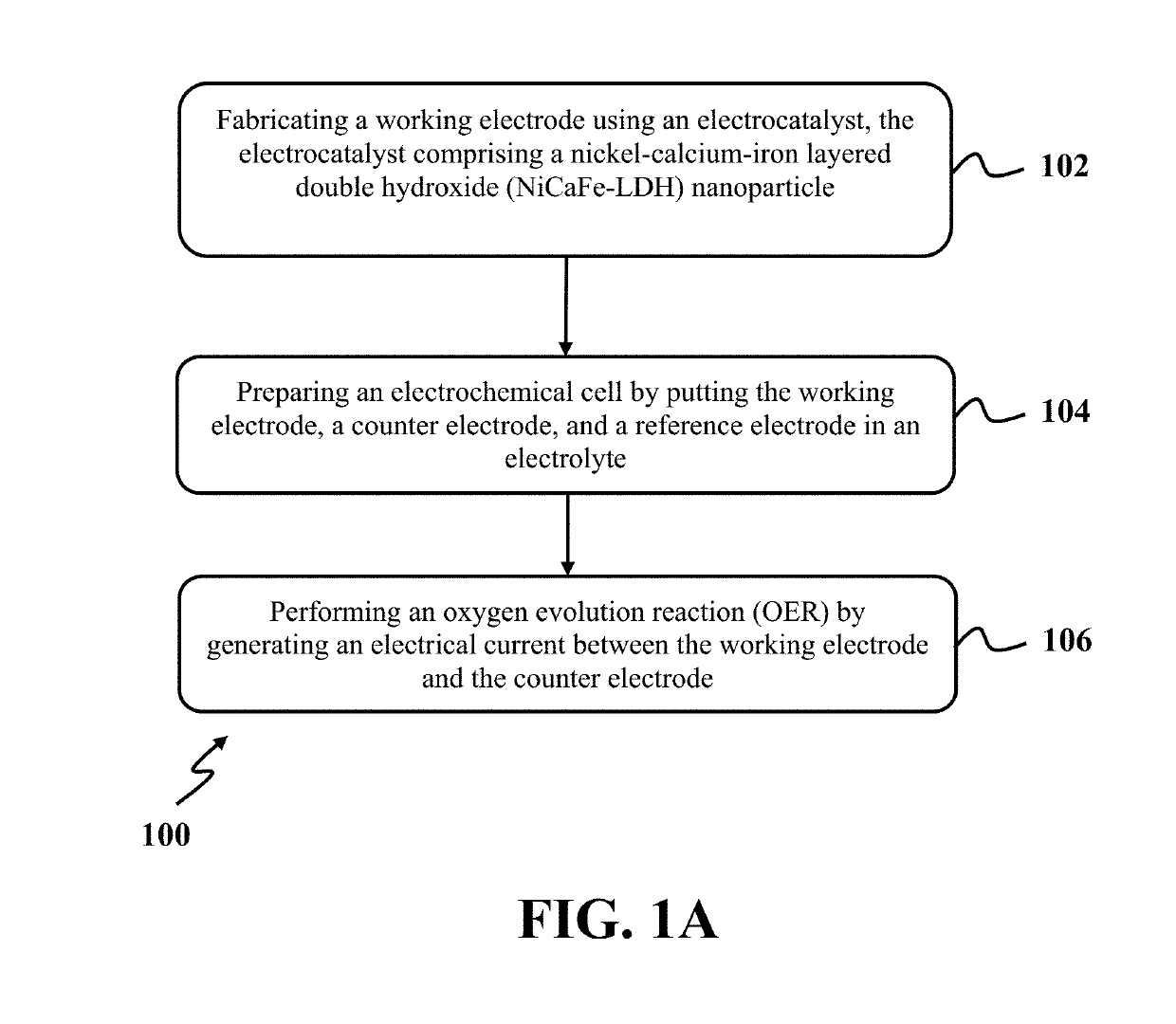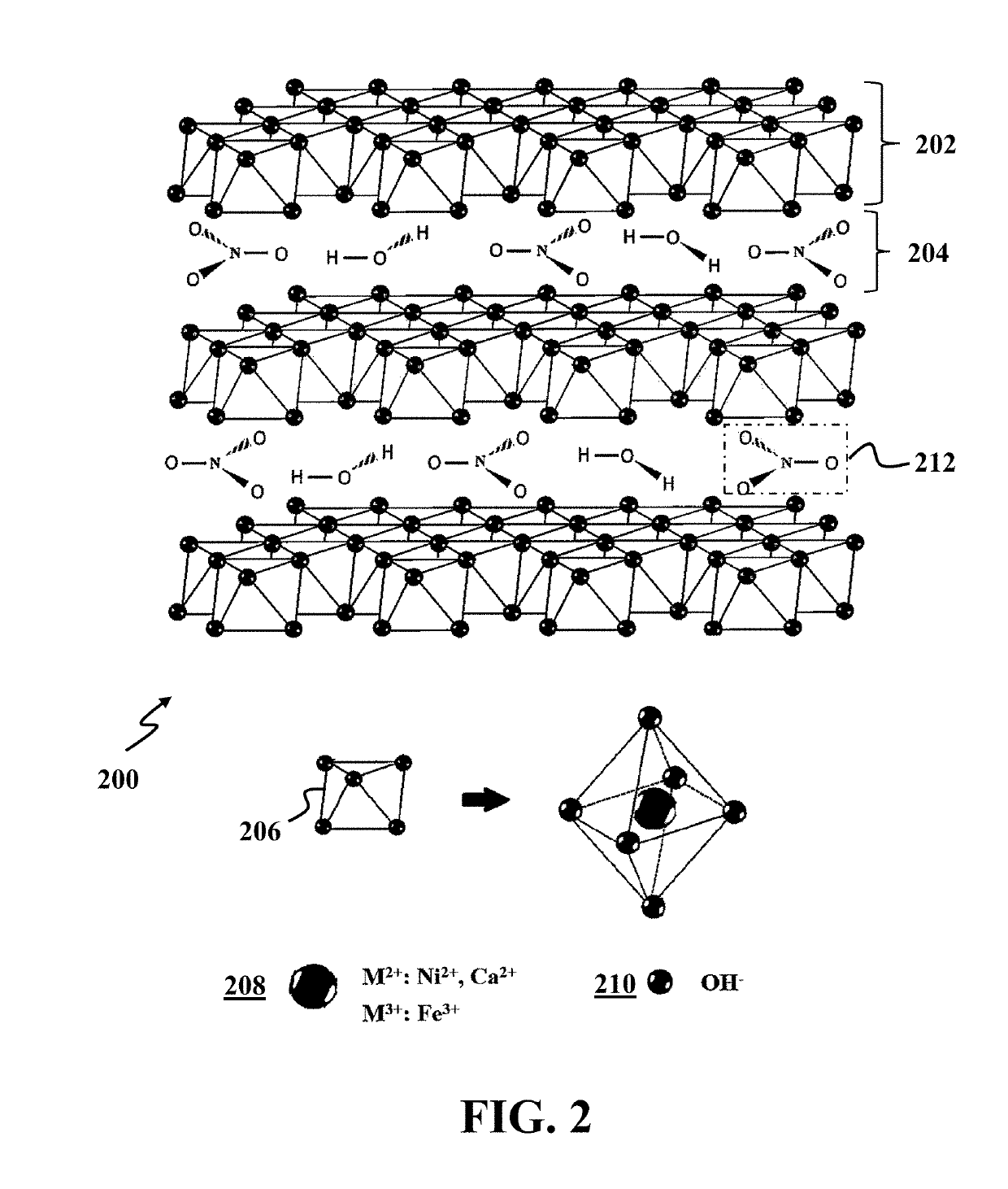Oxidation of water using layered double hydroxide catalysts
a technology of layered double hydroxide and catalyst, which is applied in the direction of electrolytic processes, electrical devices, electrolytic processes, etc., can solve the problems of low energy conversion efficiency, slow oer kinetics, and limited industrial applications
- Summary
- Abstract
- Description
- Claims
- Application Information
AI Technical Summary
Benefits of technology
Problems solved by technology
Method used
Image
Examples
example 1
of the Exemplary Electrocatalyst
[0041]In this example, exemplary NiCaFe-LDH nanoparticles as the exemplary electrocatalyst were synthesized using an exemplary hydrothermal method and an exemplary co-precipitation method. At first, calcium oxide (CaO) particles were synthesized by calcinating an eggshell. The eggshell was washed with water, dried at room temperature, and crushed with a mortar. After that, crushed eggshell was calcinated at a temperature between about 950° C. and 990° C. for a time period of about 6 hours until obtaining a white powder of calcium oxide. FIG. 3A illustrates an X-ray diffraction (XRD) spectrum of an eggshell after calcination, consistent with one or more exemplary embodiments of the present disclosure. Referring to FIG. 3A, the presence of peaks at a 20 degree of 32, 37.5, 54, 64.5, and 67.5 indicate XRD pattern of calcium oxide and formation of calcium oxide (CaO) particles after calcination.
[0042]In order to synthesize the exemplary NiCaFe-LDH nanopar...
example 2
ization of the Exemplary Electrocatalyst
[0048]In this example, the exemplary NiCaFe-LDH nanoparticles of EXAMPLE 1 were characterized using scanning electron microscopy (SEM), elemental mapping analysis, and physical adsorption assay (BET analysis). FIG. 4 illustrates a scanning electron microscopy (SEM) image of the exemplary NiCaFe-LDH nanoparticles synthesized in a hydrothermal method, consistent with one or more exemplary embodiments of the present disclosure. Referring to FIG. 4, the synthesized NiCaFe-LDH nanoparticles have a spherical morphology with a particle size between 8 nm and 14 nm.
[0049]FIG. 5 illustrates an elemental mapping image of the exemplary NiCaFe-LDH nanoparticles synthesized in a hydrothermal method, consistent with one or more exemplary embodiments of the present disclosure. Referring to FIG. 5, elemental mapping analysis confirms the existence of calcium 500, nickel 502, and iron 504 in the structure of the exemplary NiCaFe-LDH nanoparticles. Moreover, the...
example 3
of Water Using the Exemplary Electrocatalyst
[0052]In this example, the exemplary NiCaFe-LDH nanoparticles synthesized in EXAMPLE 1 were used as the exemplary electrocatalyst for oxidizing water. At first, a working electrode was produced by modifying a carbon paste electrode (CPE) with the NiCaFe-LDH nanoparticles. In order to produce modified CPE, about 0.06 g of the NiCaFe-LDH nanoparticles, about 0.22 g of graphite powder, and about 1 or 2 drops of paraffin oil were mixed with mortar to obtain a homogeneous wet paste. After that, the homogeneous wet paste of the electrocatalyst was firmly packed into a cavity of a glass or a plastic tube. The same approach was used for the preparation of unmodified CPE. Also, surfaces of all the modified and unmodified CPEs were smoothed on weighing paper prior to each measurement and then rinsed with double distilled water.
[0053]In the next step, an electrochemical cell was prepared by putting modified CPE as the working electrode, platinum (Pt)...
PUM
 Login to View More
Login to View More Abstract
Description
Claims
Application Information
 Login to View More
Login to View More - R&D
- Intellectual Property
- Life Sciences
- Materials
- Tech Scout
- Unparalleled Data Quality
- Higher Quality Content
- 60% Fewer Hallucinations
Browse by: Latest US Patents, China's latest patents, Technical Efficacy Thesaurus, Application Domain, Technology Topic, Popular Technical Reports.
© 2025 PatSnap. All rights reserved.Legal|Privacy policy|Modern Slavery Act Transparency Statement|Sitemap|About US| Contact US: help@patsnap.com



